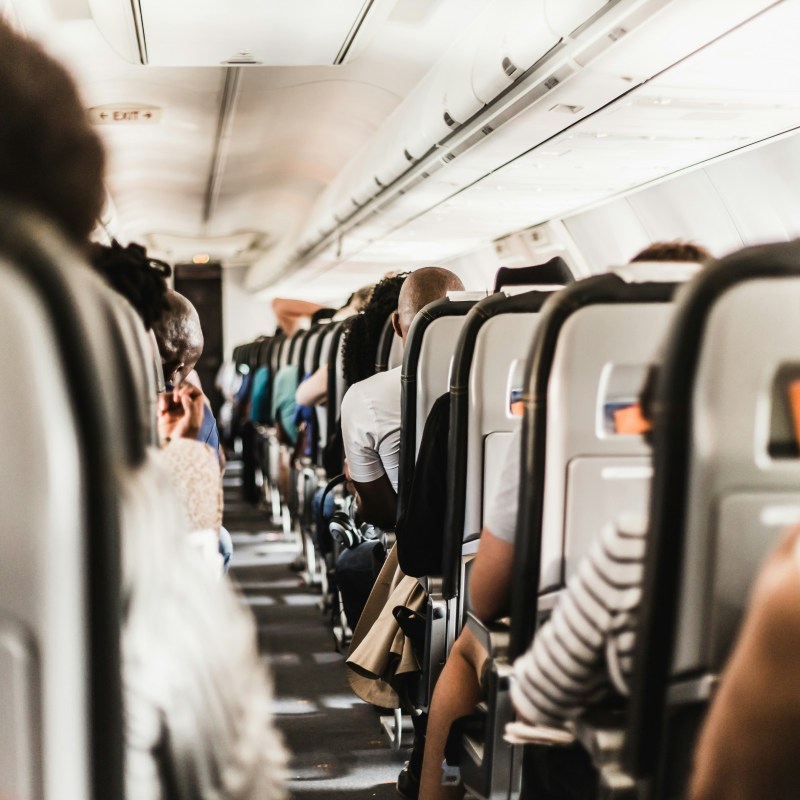
Plane travel isn’t quite how it used to be.
Videos by TravelAwaits
I wouldn’t say that plane travel was ever magical, per se. However, air travel used to demand more patience. Flight routes weren’t nearly as vast, while budget airlines were few and far between. Staff tended to be less overworked, and legroom wasn’t a pipe dream.
These factors helped create flights with fewer hiccups. At least, when it comes to etiquette.
Larger planes and better service helped make up for passengers who seemed to spawn from alien planets.
After all, most passengers knew intuitively not to put their bare feet onto armrests, not to bring on super-stinky foods, and to give middle passengers dibs on the armrests.
Most travelers also knew when to give a bit of grace. For example, kids kicking seatbacks might just need a little time to get adjusted to the flight.
But with more flight disruptions, worse airport experiences, smaller planes, and slashes to just about every service in the airline industry, etiquette matters.
How we treat one another in the airport and on the plane is the last line of defense for our sanity.
So what’s the modern take on plane etiquette? Let’s explore the most important factors according to travel bloggers, flight attendants, and other industry pros.
Plane etiquette 101
Airplane mode isn’t a suggestion
This really isn’t a question of etiquette—it’s an example of following the rules that are instated for safety purposes. Smartphones, especially those with 5G connections, can cause interference with aircraft navigation and communication tools.
Do you really want to make the job of piloting a commercial airplane any more difficult?
The overhead bins are precious
Every time someone stuffs their coat or handbag into the overhead cabin, another passenger loses the chance to store their full-sized carry-on. So, let’s reiterate: The overhead cabin is strictly for luggage.
Suitcases get priority over backpacks, so long as backpacks fit beneath the seat in front of you. If your backpack is your carry-on, then feel free to use the overhead bins.
Put your bag by your seat
Let’s make another specification when it comes to the overhead bins: You should use the space that correlates to your seat. When you put your bag above someone else’s seat, you’re taking the space set aside for their luggage.
On the other hand, if you notice that all passengers are seated in their row and see an open space, it’s fair game.
Always use headphones
I’m surprised to clarify this, but it seems to be a growing problem—especially when it comes to younger flyers and children. No matter who is watching content or listening to music, they should be using headphones. Remember that air travel is already stressful, and nothing compounds stress like obnoxious noises.
Watch the window blinds
Everyone enjoys taking a peek out of the windows. (And it’s considered good etiquette to make sure others in your row can see out of the window when landing.)
But be mindful when the sun is shining brightly. It could be uncomfortable for passengers sitting in direct light. Additionally, bright light can reflect off of glass screens to create a really painful glare for passengers seated in other rows.
Treat staff respectfully
Similar to using headphones, this type of etiquette probably seems more self-evident than it is. Even a smile can go a long way for flight staff who are having a difficult day. I hear it can even get you a few extras, like a bottle of water or a spare treat… or even access to the emergency rows and their life-giving legroom.
No chatting necessary
A bit of small talk is normal on most flights, especially as passengers get situated in their row. But there’s nothing worse than a busybody who wants to chat through a two-hour-long flight.
Respect the signs that others might not be open to small talk. And don’t feel bad that they don’t want to chat—who knows what kind of airport experience they’re trying to survive? On top of that, who knows why they’re traveling? Not everyone is on vacation, after all.
Recline mindfully
There’s no fast-and-easy rule when it comes to reclining. Overwhelmingly, the decision should be based on the person sitting behind you. After all, etiquette is about making things easier for those around us.
Here’s what seasoned travelers and flight staff advise: If someone is eating, don’t recline. If someone is trying to work on a laptop or paper, don’t recline. If someone is visibly uncomfortable in their seat, don’t recline.
If I had to put it poetically: Every time you choose not to recline your seat, an angel gets its wings.
